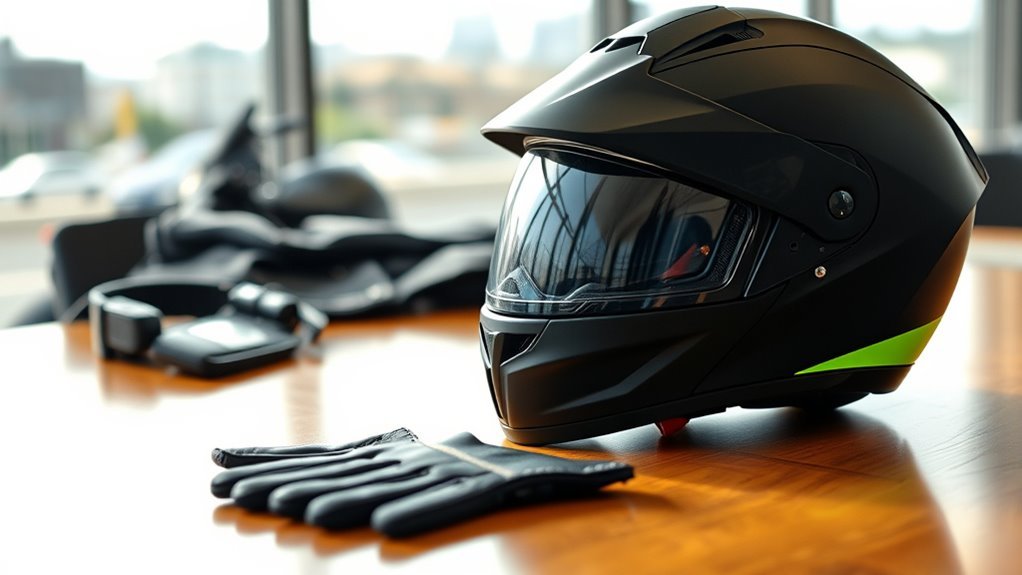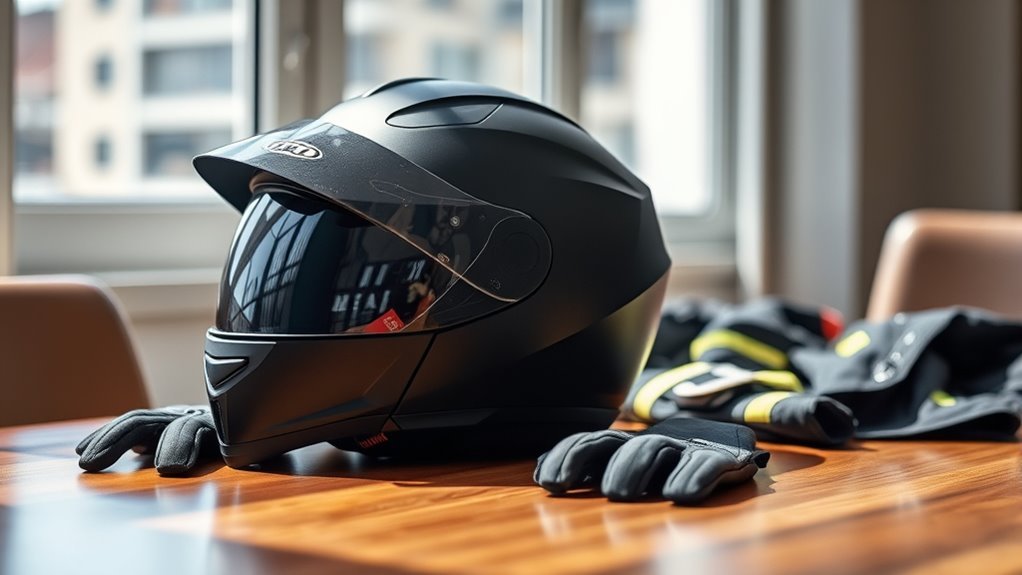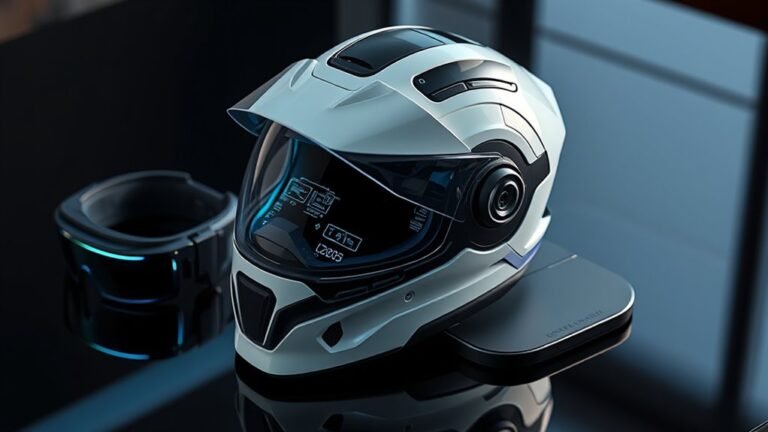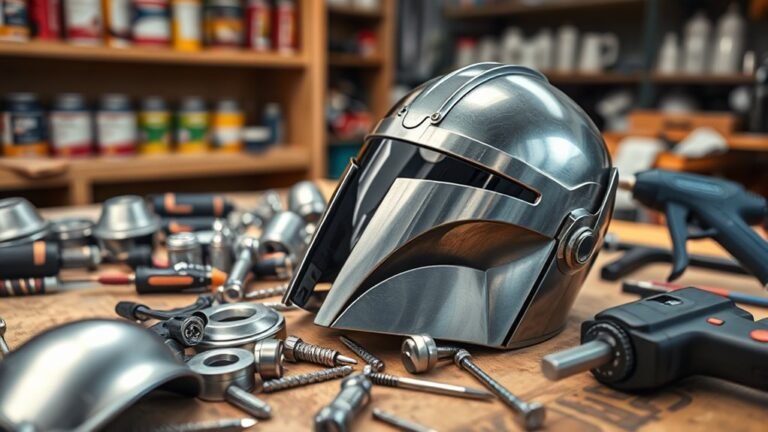Best Motorcycle Helmets for Commuting
When choosing the best motorcycle helmets for commuting, it’s crucial to take into account safety certifications like DOT or ECE, ensuring maximum protection. Prioritize fit and comfort; a well-fitted helmet enhances safety and reduces fatigue. Full face or modular helmets offer great protection and ventilation options. Look for features like lightweight designs and effective noise reduction. Customization lets you express your style too. Keep exploring options to find the right helmet for your daily rides and discover more important features.
Safety Standards and Certifications

When you’re choosing a motorcycle helmet for commuting, understanding safety standards and certifications is essential, as they guarantee you’re protected on the road. Look for helmets that meet or exceed safety certifications like DOT, ECE, or Snell. These certifications confirm the helmet has undergone rigorous testing for impact resistance, penetration, and retention system strength. Helmet ratings can also provide insights into performance; higher-rated helmets generally offer superior protection. Be certain to check for additional safety features, such as reflective materials for visibility and multi-directional impact protection. By prioritizing helmets that adhere to these safety standards, you’re not just making a purchase—you’re investing in your freedom to ride confidently, knowing you’re safeguarded against potential risks.
Importance of Fit and Comfort

When choosing a motorcycle helmet for commuting, the right fit is essential for both safety and comfort. A helmet that’s too loose or too tight can lead to discomfort during rides, while proper padding and ventilation enhance your overall experience. Ensuring the correct size and adequate airflow can make a significant difference in your daily commute.
Helmet Size Matters
Since a motorcycle helmet is your first line of defense on the road, getting the right size is vital for both safety and comfort. Using effective helmet measurement techniques is important. A proper fit can prevent injuries during a crash and reduce discomfort during your ride. To guarantee you’re choosing the right size, refer to a helmet fitting guide.
Here’s a quick size reference:
| Size | Head Circumference (inches) | Head Circumference (cm) |
|---|---|---|
| Small | 20.5 – 21.25 | 52 – 54 |
| Medium | 21.25 – 22 | 54 – 56 |
| Large | 22 – 23.25 | 56 – 59 |
Finding your perfect fit enhances your freedom on the road, allowing you to ride with confidence.
Padding and Ventilation
While the right fit is essential for safety, padding and ventilation play equally important roles in ensuring comfort during your rides. High-quality padding materials, such as foam or gel, contour to your head, reducing pressure points and enhancing comfort over long distances. Look for helmets with removable liners for easy cleaning, as sweat can accumulate during your commute. Additionally, effective ventilation design is vital; strategically placed vents allow airflow, preventing overheating and ensuring you stay cool on warm days. A well-ventilated helmet can also reduce fogging on visors, improving visibility. Balancing padding and ventilation will not only enhance your comfort but also contribute to a more enjoyable riding experience, allowing you to embrace the freedom of the open road.
Types of Motorcycle Helmets

Motorcycle helmets come in various types, each designed to meet specific riding needs and preferences. Full face helmets offer the highest level of protection, enclosing your entire head and face with a hard shell, ideal for high-speed commuting. They reduce wind resistance and provide excellent noise reduction, enhancing your riding experience.
On the other hand, modular helmets blend the benefits of full face helmets with the versatility of open face designs. You can flip up the chin bar for added ventilation or easy communication without removing the helmet. This makes them a popular choice for daily commuters who want flexibility without sacrificing safety. Choosing the right helmet type is essential for both your comfort and protection on the road.
Lightweight Options for Daily Use
When commuting on two wheels, finding a lightweight helmet can greatly enhance your riding experience. Opting for helmets made from advanced lightweight materials such as polycarbonate or carbon fiber not only reduces fatigue during long rides but also increases comfort. These materials provide excellent protection while maintaining a low weight, making them ideal for daily use. You’ll appreciate the commuting convenience they offer, as they’re easier to wear and store. Many lightweight models also feature streamlined designs, ensuring you can navigate through traffic effortlessly. Remember, a helmet that feels light and comfortable lets you focus on the ride, allowing you to enjoy that sense of freedom that comes with every journey. Choose wisely, and make your commute a breeze.
Advanced Ventilation Features
When commuting, effective airflow management is essential for comfort and safety. Look for helmets equipped with advanced ventilation features like moisture-wicking liners and adjustable ventilation ports to enhance airflow and regulate temperature. These elements work together to keep you cool and focused on the road.
Airflow Management Systems
While riding, maintaining ideal airflow is crucial for comfort and safety, especially during long commutes. Helmets equipped with advanced airflow management systems can greatly enhance your riding experience. These systems utilize strategically designed airflow channels that direct fresh air into the helmet while expelling hot air. This dynamic process guarantees optimal ventilation, keeping your head cool and focused on the road ahead. Look for helmets featuring innovative cooling technology, such as adjustable vents that allow you to customize airflow based on weather conditions. A well-ventilated helmet not only alleviates fatigue but also reduces the risk of heat-related issues, letting you enjoy the freedom of the ride without distraction. Prioritize airflow management for a more enjoyable commute.
Moisture-Wicking Liners
In addition to effective airflow management, moisture-wicking liners greatly enhance the comfort of your helmet during commutes. These liners utilize breathable materials that actively pull sweat away from your skin, ensuring ideal moisture control. When you’re maneuvering through urban traffic or cruising on open roads, staying dry can considerably improve your riding experience. Helmets equipped with these advanced liners help regulate temperature, reducing the risk of overheating and discomfort from trapped moisture. This feature is especially important during warmer months or long rides when sweat can accumulate quickly. By investing in a helmet that prioritizes moisture-wicking technology, you not only enhance your comfort but also enjoy a more focused and enjoyable ride. Embrace the freedom of the road with confidence!
Adjustable Ventilation Ports
Adjustable ventilation ports are an important feature for any commuter helmet, allowing you to customize airflow according to your needs. With adjustable airflow, you can enhance your riding experience, ensuring ideal comfort during diverse weather conditions. This is vital for maintaining ventilation efficiency, especially on long rides.
| Feature | Benefit |
|---|---|
| Adjustable Ports | Tailor airflow to conditions |
| Increased Airflow | Reduces heat buildup |
| Easy Operation | Quick adjustments on the go |
| Enhanced Comfort | Keeps you focused and cool |
Noise Reduction and Communication Systems
Choosing a helmet with effective noise reduction capabilities can greatly enhance your commuting experience, as it not only minimizes distractions from wind and road noise but also allows for clearer communication. Look for helmets featuring advanced noise cancelling technology, which actively reduces unwanted sounds while you ride. This can make your journey more enjoyable and less fatiguing, especially during longer commutes.
Additionally, consider helmets with Bluetooth integration. This allows you to connect to your smartphone or GPS for hands-free communication, music streaming, or navigation. With these features, you can stay connected without compromising your focus on the road. Prioritizing noise reduction and communication systems will guarantee you can enjoy the freedom of the open road while staying in touch with the world around you.
Style and Customization Choices
When it comes to selecting a motorcycle helmet, style and customization choices play an essential role in guaranteeing you find a perfect fit for your personality and riding needs. Helmets are available in various style variations, from full-face to open-face designs, allowing you to express your individuality. Additionally, many manufacturers offer custom graphics options, enabling you to personalize your helmet further.
| Style Variation | Custom Graphics Available |
|---|---|
| Full-Face | Yes |
| Modular | Yes |
| Open-Face | Limited |
Choosing the right combination of style and customization not only enhances your riding experience but also guarantees you feel confident on the road. Make sure to explore these options to find a helmet that truly represents you.
Budget-Friendly Helmets
Finding the right motorcycle helmet on a budget doesn’t have to be an intimidating task. There are plenty of affordable options that offer both safety and comfort without breaking the bank. When searching for budget alternatives, focus on reputable brands that meet safety standards like DOT or ECE ratings. Helmets in the mid-range price bracket often feature essential technologies like ventilation systems and removable liners, enhancing your riding experience. Look for lightweight designs that minimize fatigue during your commute. Remember, investing in a quality helmet is vital for your safety, so don’t compromise on protection just to save a few bucks. With a little research, you can find a helmet that suits your style and budget perfectly.
Top Recommendations for Commuters
While it’s essential to prioritize safety and comfort, selecting the right helmet for your daily commute can greatly enhance your riding experience. Here are top recommendations that emphasize commuter convenience and advanced helmet technology:
Prioritizing safety and comfort, choosing the right helmet can significantly improve your daily riding experience.
- Shoei RF-1400: This model offers superior aerodynamic design and excellent noise reduction, perfect for urban environments.
- Bell Qualifier DLX: Equipped with a drop-down sun visor and Bluetooth compatibility, it combines versatility with modern tech features.
- AGV K6: Lightweight and durable, this helmet provides ideal ventilation and a snug fit, ensuring comfort on longer rides.
Frequently Asked Questions
How Often Should I Replace My Motorcycle Helmet?
You should replace your motorcycle helmet every five years, regardless of its condition. Helmets have a limited lifespan due to materials degrading over time, even if you haven’t had an accident. Always check for compliance with current safety standards, as older helmets may not meet them. If your helmet has been involved in a crash, replace it immediately. Prioritizing your safety guarantees you can enjoy the freedom of the ride without worry.
Can I Wear Glasses With My Motorcycle Helmet?
Yes, you can wear glasses with your motorcycle helmet, but you’ll need to guarantee proper glasses compatibility and helmet fit. Many helmets are designed to accommodate glasses, featuring cutouts or extra space around the temples. When trying on a helmet, wear your glasses to check that they fit comfortably without pinching. Always prioritize a snug fit to maintain safety while riding, as loose helmets can shift and compromise protection.
What Materials Are Motorcycle Helmets Made From?
Motorcycle helmets are typically made from lightweight materials like polycarbonate, fiberglass, and carbon fiber. These materials not only enhance comfort but also contribute to helmet safety features, such as impact resistance and durability. A well-constructed helmet balances weight and protection, allowing you to enjoy the freedom of the ride without compromising safety. When choosing a helmet, consider these materials to guarantee you’ve got the right blend of safety and comfort for your journeys.
Are Modular Helmets Safe for Commuting?
Yes, modular helmets can be safe for commuting, provided they meet safety standards like DOT or ECE. These helmets combine the benefits of full-face and open-face designs, allowing flexibility and ventilation. Look for features like a robust chin bar, impact-resistant materials, and a secure locking mechanism to enhance modular helmet safety. With a comfortable fit and quality padding, you’ll enjoy the freedom of the ride while staying protected on your daily journeys.
How Do I Clean and Maintain My Helmet?
To clean and maintain your helmet, start with helmet care by removing the inner lining and washing it in mild soap and water. Use a soft cloth for the outer shell, avoiding harsh chemicals. Rinse thoroughly and allow both parts to air dry. Regularly check for scratches or damage, ensuring your helmet stays safe. Follow these cleaning tips to prolong the life of your helmet and enjoy the freedom of riding with confidence.






